Introduction
Termites have been around for over 250 million years. They are social insects and live in colonies which are usually located in the ground or in wood. Most termites feed on cellulose from wood and wood by-products such as paper. They are worldwide in distribution with about 2,500 described species and about 30 species are found in Hong Kong.
Termites are usually divided into 3 groups based on the location of their colony; the subterranean, the drywood, and the dampwood termites. The biology and habits of each group are different, so a detailed knowledge of each is necessary for effective control. Amount the three groups, species Coptotermes formosanus (or commonly called Formosan subterranean termite) is the most common and economically important termite in Hong Kong and South China.
Termites are social insects and the colonies contain castes or groups of individuals who share the same body form and job description. Subterranean termites have three castes: worker, soldier and reproductive. Drywood and dampwood termites lack a true worker caste, and their functions are performed by preadults which ultimately develop into soldiers or reproductive.
Workers are sterile who maintain the colony, construct and repair the nest, and forage and feed the colony; Soldiers are sterile and have one function, to protect the colony. The enlargement of the head and mandibles is such that they must be fed by workers. They are present in far fewer numbers than workers; Reproductives include the primary reproductive and secondary reproductive. The primary reproductive are the king and queen which were the swarmers that started the colony. The king and queen mate periodically, and the queen may live up to 30 year, perhaps longer. Secondary reproductive are produced in more mature colonies. Their egg production makes possible the most rapid increase in size of older colonies. If something happen to the primary reproductives, they can serve as replacements.
New colonies can be started by a founding pair of swarmers, it occurs after the swarming flight. Mated queens lay few eggs the first year, as few as 0-22eggs. At the end of the first year, a subterranean termite colony may number as many as 75 individuals. So it may take s 3 or 4 years or even longer are required before a newly-constructed building will show signs of a termite infestation. However, if the structure is built over or close to a strong existing colony of subterranean termites, hundreds of swarmers or substantial damaged may be noticed within a year.
Formosan subterranean termite
This termite is very economically important is because of the large size of the colony (more than 8,000,000 individual termite on record), a mature queen can lay as many as 1,000 eggs per day and, hence, the termites’ ability to consume a large amount of wood in a relatively short period of time and to produce large evening flights of swarmers.
Formosan termites are subterranean termites, they typically live in the ground, build mud tubes, and have a 3-caste system. Swarming usually follows a warm rainy day in late spring/summer and typically occurs in the evening hours, starting at sunset and ending before midnight. The swarmers are attracted to lights.
Formosans do have the habit of establishing secondary nests above ground if a constant moisture supply is available. Such a nest is made of a materials called carton. It consists of soil and wood cemented together with saliva and feces. True aerial nests (never ground contact) are more often encountered in high-rise building in Hong Kong.
Damaged wood caused by Formosan termite appearing layered and soil present and the large carton constructions caused walls to bulge. Although colonies of several million termites are known, a mature colony consisting of about 350,000 workers can eat about 31 grams per day. At this rate, such a colony could completely consume 4.3 liner metres of a pine board in 1 year. However, some mature colony may be as much as 2-28 times timers this larger or there may be more than 1 colony present in the structure. And the maximum foraging distance can up to 115 metres. As an established, mature colony of Formosan termite may cause severe damage to a structure in as shot a time as 3 months. For this reason, it should be control immediately once found.
Control
Termite control begins with a thorough inspection of the structure and the specie of termite found.
For subterranean termite, it involves:
‧ Placing a pesticide chemical barrier between the termite colony and the wood of the structure;
‧ Placing in-ground monitoring-baiting system surrounding building perimeter;
‧ Elimination of above-ground moisture sources (such as water leakage in bathroom) which can support secondary colonies;
‧ Reduce wood moisture content to below 20%;
‧ Elimination of wood-to-ground contact;
‧ Remove any wood debris;
‧ Injection of infested wood to rapidly kill the above-ground termites;
‧ Place above-ground termite baiting systems directly on the termite infested wood.
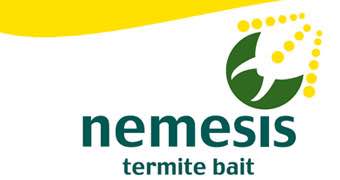
↑Know more Nemesis termite baiting system
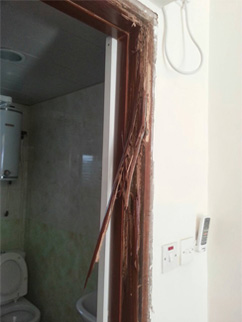
Door frame was damaged by termite
Inferestation
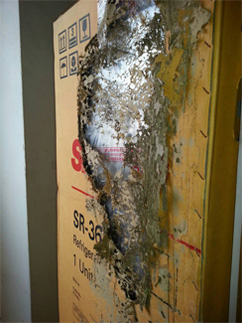
Not only timber structure, Termite also
damage paper, cloth, carpets, and other
cellulosic materials.
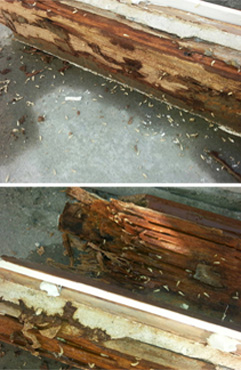
Active termite were found in the inferested
wooden structure.
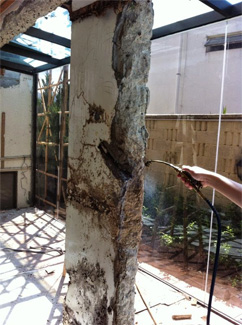
Our technician was spraying pesticide on
the premise.




